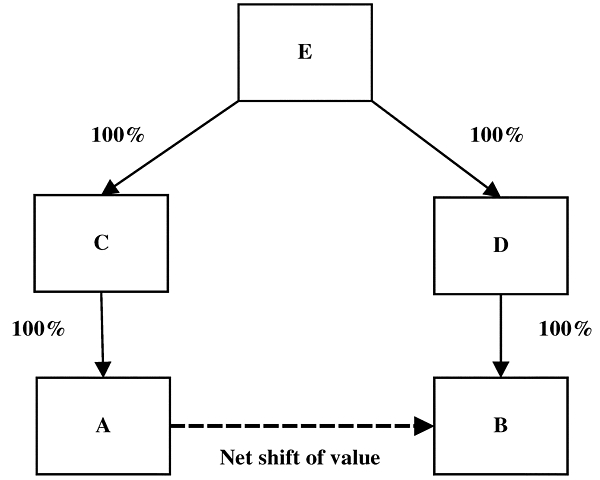Income Tax Assessment Act 1997
An indirect value shift arises when there is a net shift of value from one entity to another.
Example:
Company A transfers property to company B in return for a cash payment. If the market value of the property is $ 180 million but the cash payment is only $ 50 million, there is a net shift of value from company A to company B of $ 130 million.
727-5(2)
It is called indirect because the transaction will have the indirect effect of shifting value from equity or loan interests in the losing entity to equity or loan interests in the gaining entity.
This is because the net shift in value between the entities will usually decrease the market value of interests in the losing entity and increase the market value of interests in the gaining entity.
Example:
Assume that company C owns all the shares in company A and company D owns all the shares in company B. The net shift of value from company A to company B will reduce the value of company C ' s shares in company A and increase the value of company D ' s shares in company B.
727-5(3)
It will also produce corresponding effects further up a chain of entities.
Example:
Assume that company E owns all the shares in company C and company D. The net shift of value from company A to company B will also reduce the value of company E ' s shares in company C and increase the value of its shares in company D.

727-5(4)
This Division is not concerned with the tax treatment of the net shift in value between the entities at the bottom of the chains. Instead, it deals with the effects on the market value of interests (both direct and indirect) in those entities.
727-5(5)
An indirect value shift distorts the relationship between the market value of an equity or loan interest and its value for income tax purposes. When the interest is realised, this can produce an inappropriate loss for income tax purposes, or an inappropriate gain.
Example:
If company E sold its shares in company C, the indirect value shift could (apart from this Division) result in a loss for income tax purposes. Company E could defer the corresponding gain on its shares in company D by not selling these.
Disclaimer and notice of copyright applicable to materials provided by CCH Australia Limited
CCH Australia Limited ("CCH") believes that all information which it has provided in this site is accurate and reliable, but gives no warranty of accuracy or reliability of such information to the reader or any third party. The information provided by CCH is not legal or professional advice. To the extent permitted by law, no responsibility for damages or loss arising in any way out of or in connection with or incidental to any errors or omissions in any information provided is accepted by CCH or by persons involved in the preparation and provision of the information, whether arising from negligence or otherwise, from the use of or results obtained from information supplied by CCH.
The information provided by CCH includes history notes and other value-added features which are subject to CCH copyright. No CCH material may be copied, reproduced, republished, uploaded, posted, transmitted, or distributed in any way, except that you may download one copy for your personal use only, provided you keep intact all copyright and other proprietary notices. In particular, the reproduction of any part of the information for sale or incorporation in any product intended for sale is prohibited without CCH's prior consent.

 View history note
View history note Hide history note
Hide history note